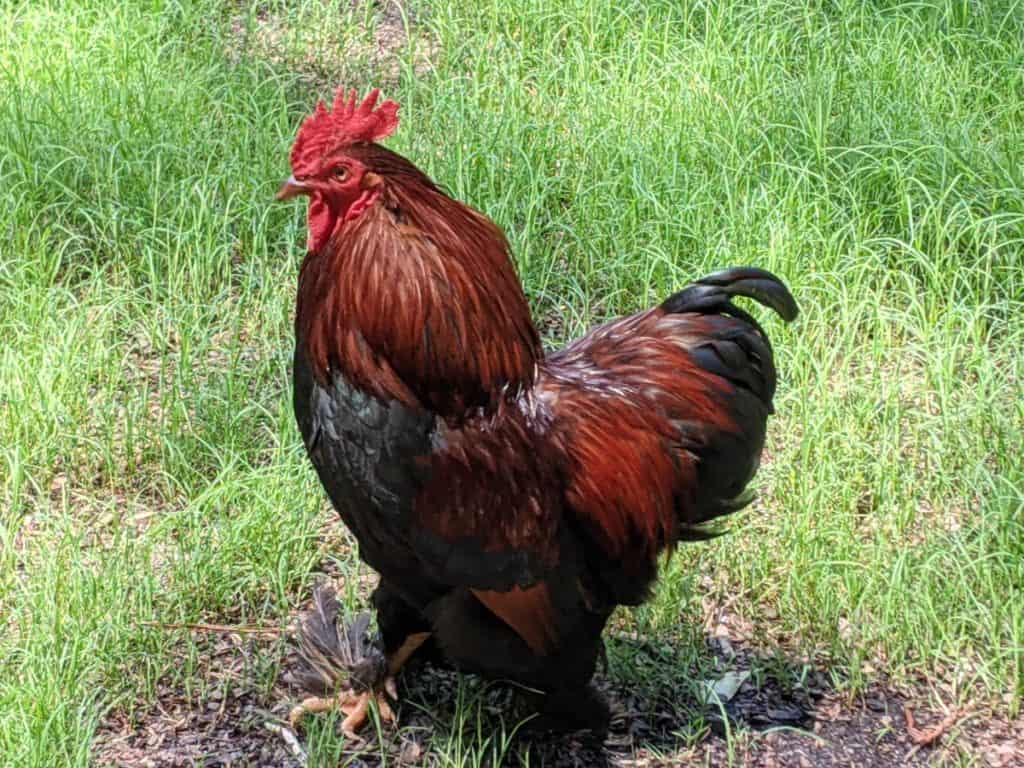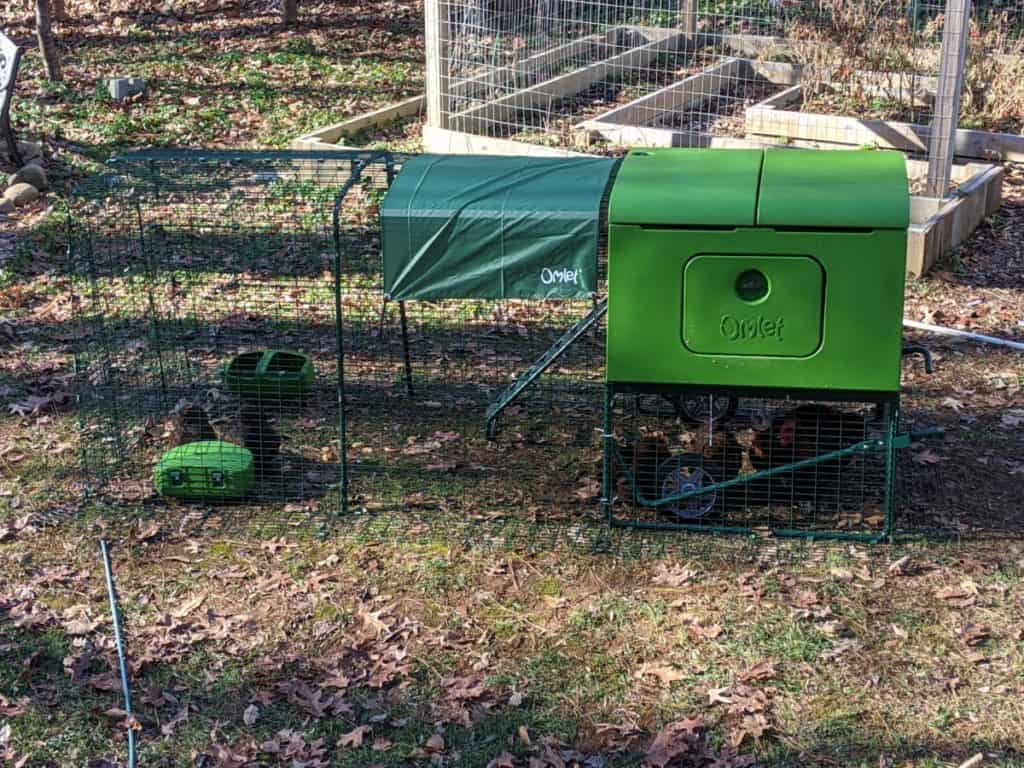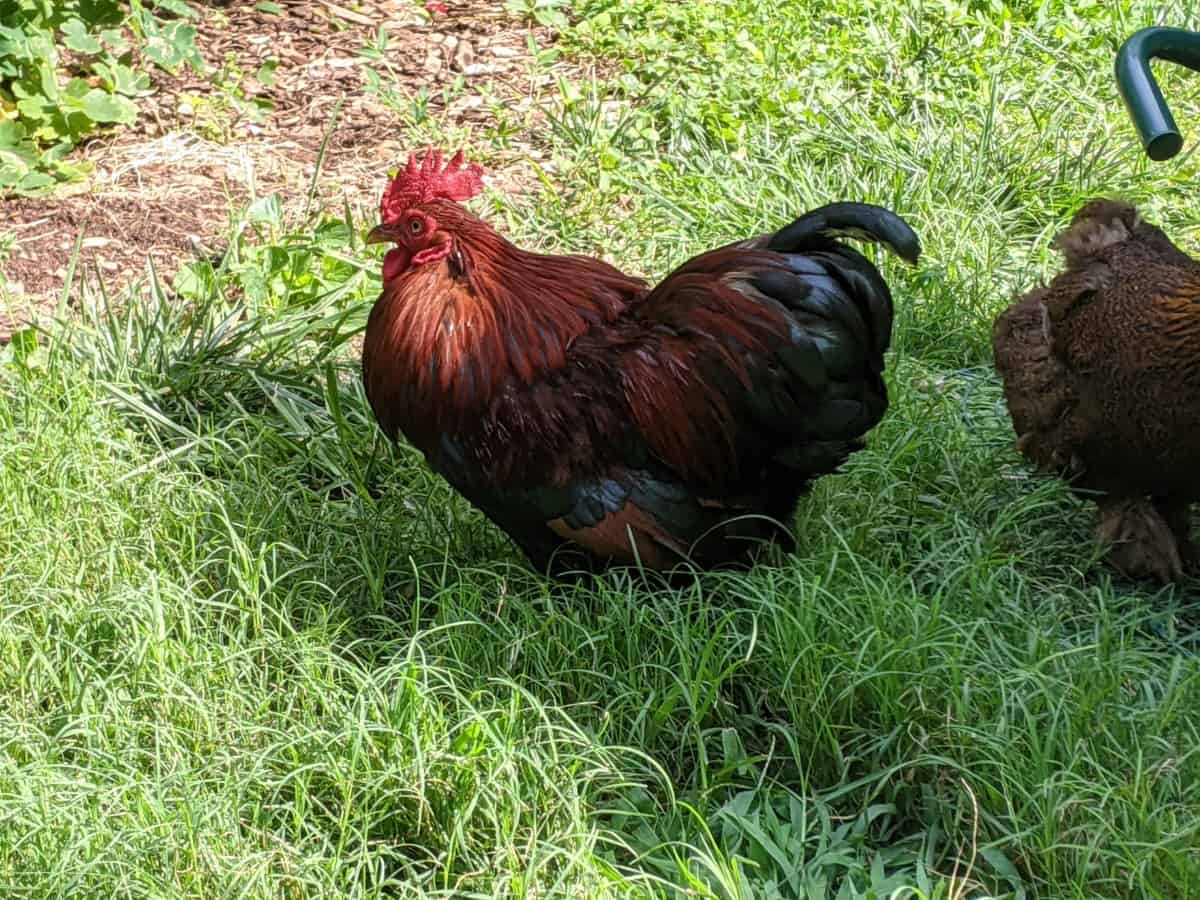You will notice some dominant behavior among your hens if you keep chickens, either as a free-range flock or confines to a coop. They will fight to settle a pecking order, and roosters will fight over hens.
Chickens have very sharp claws, and their toes are flexible and powerful to allow them to dog for food. And protect themselves! Those claws are not just for settling flock hierarchy but for defense and protection against predators and enemies.
Chickens are heavy birds, not well adapted to flying. To defend themselves on the ground, they have strong, flexible toes with sharp claws. Roosters have an advantage over hens as they have a pointed keratin-covered spur on the back of their legs which they use while fighting.
A chicken’s natural form of defense is beneficial as they have only limited ability to fly away from any enemies. As a chicken owner, if you’ve seen your chickens going to roost at night, you will know precisely how clumsy and short their flights are.
Backyard chickens may be reasonably safe from predators, but there’s always a chance a possum, coyote, or hawk can get to a flock. Chicken owners have found some ways of helping to keep their flocks safe since leaving a chicken to defend itself with only its claws is not the best solution.
If you have a free-range flock in North America, you may find that you will extra help to keep your chickens safe from predatory birds. Extra cover in the form of places they can hide and a watchful rooster will make a big difference on most farms.
Depending on how you keep your backyard flock, there are various methods you can use to help your chickens stay safe.

How Does A Chicken Defend Itself
Chickens have powerful legs and toes that end in sharp claws. These claws are necessary for them to scratch for food on hard ground and defend themselves from potential predators.
Chickens are flock birds who do best in groups where every member of the flock knows their place. Birds will fight among themselves to establish a pecking order.
Roosters protect the flock
Roosters typically gather flocks of around 12-15 hens, and if you keep your chickens in a free-range environment with several roosters, they will usually split up into several smaller flocks.
These roosters are amply weaponed with a large backward-pointing extra toe on the back of their legs. This is the spur, made from the same material as fingernails – keratin – and is very sharp. While all chickens have sharp claws for defense, only the roosters grow large fighting spurs to project the entire flock.
The roosters will be on their guard all the time, keeping watch and ready to defend their hens from dangers – predators and other roosters. Unfortunately, sometimes they decide the chicken owners are predators too!
When a rooster routinely attacks humans, it’s best to remove that particular bird as it will be a danger to you or other people. Cuts from spurs can easily become infected and are very nasty and painful injuries.
Chickens seek out high places
When sleeping, chickens will try to find a high place to roost for the night to put them out of the reach of ground-based predators.
You can use this instinct to help keep your chickens safer by providing cover for free-range chickens or encouraging them to be enclosed into a hen house at night.
Chickens are fast
Chickens also are speedy little birds. If you have chickens you know chasing one down can be quite the workout when trying to get them in the coop at night. This speed is important when running from a dog, possum, or other animals.
Chickens are good at hiding
My flock often hides under bushes to keep hidden from high-flying hawks and other animals. If our rooster senses danger he will often gather the flock and go under our deck until the danger passes.
How To Protect Chickens From Predators
The biggest predators of chickens in North America range from bobcats, foxes, coyotes, and weasels, to dogs and house cats. Snakes are another culprit, particularly the rat snake, and hawks and owls such as the red-tailed hawk, red-shouldered hawks, and great horned owls.
Larger predators will go for adult chickens, while smaller ones such as snakes or rats will take chicks. Birds of prey will snatch birds during the day (hawks) or night (owls). Snakes, rats, opossums, and crows will also steal eggs if they can access the nesting boxes.

So how do you protect your chickens from all these predators?
If your chickens are free-range, you can enclose them in an area using movable fencing that will keep out animals like dogs or coyotes. You can discourage birds of prey by eliminating vantage points that enable them to watch your flocks. A single tall tree gives a hawk a great bird’s-eye view of your backyard flock.
If possible, it’s best to bring free-range chickens in at night. You can encourage them to roost in a hen house at night by feeding them inside when the day begins to end. Cover your runs with orange netting to deter attacks from hawks and owls.
A movable chicken tractor is a great way to provide backyard flocks with protection while still allowing them access to new pastures.
If you have a very large flock, it might be worth getting a guard dog for protection. These dogs will stay with your flock night and day and act as a deterrent to most predators.
You can also add to flock safety with some coop and run modifications.
Do Roosters Protect Chickens From Hawks?
Not all areas will allow roosters in backyard flocks, so always check this with your local authorities. However, if you have a hawk problem, a rooster can be a very effective deterrent. They will keep an eye open for danger and send up an alarm call if they spot a hawk flying above. This call will send their flock running for cover.
A full-grown rooster will attack a hawk and try to fight it off when it swoops in for a kill. Roosters can be very violent, and they will fight to the death, using the claws, beak, spurs, even beating their opponent with their wings.
As you can see, they make a rather effective defense for a small flock. However, too many roosters in too small a space with not enough hens between them will fight each other. You will need to make sure you have enough space and hens per rooster.
Be aware that though a rooster is an excellent safeguard against hawks, they will not prevent or defend against all attacks. If hawks are a problem in your area, consider additional methods.
My rooster recently fought a hawk under our deck and survived. I heard the fight and lucky the hawk flew off when I came outside. Our rooster did his job and protected his six hens. We have hawks on the hunt every day our skies, unfortunately.
Tips To Make Your Coop Predator-Safe
Tip 1: Using food and water at dusk, train your free-range flock to return to the coop at night. This will allow them to roost and nest safely.
Tip 2: Fully enclose your chicken run with chicken wire or game-bird netting to prevent large predators such as dogs or bobcats from reaching your flock. Extend the mesh into the ground to stop burrowing animals. Enclose your coop inside the run for additional protection. The smaller mesh will prevent predators like racons from getting access.
Tip 3: Make sure you also cover the top of the run to stop birds of prey. Orange is a color that hawks and owls can see very clearly, so it is recommended you use orange wire mesh or netting on the top of your chicken run.
Tip 4: Raising the chicken coop off the ground can make it much harder for small predators such as snakes or rats to gain access. If there are any holes in the floor, seal these up as soon as possible.
Tip 5: Always close your coop door at night! There is no point in having a raised coop if the predators can still get in.
Tip 6: A motion sensor night light could be just the thing to deter the occasional predator, though this will not be helpful if you have a guard dog that has the run of the yard at night.
Conclusion
Chickens will fight to defend themselves, and the addition of a rooster to a flock will provide additional security. If you are concerned about predators, it is best to take practical measurements against small and large animals, as well as birds of prey.
There are several methods to do this, each suited to small flocks, free-range birds, and backyard flocks kept in runs.





